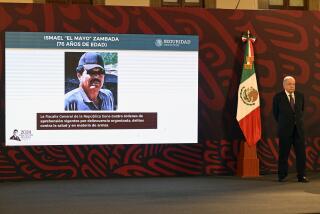1 Suspect, a World to Hide In
- Share via
WASHINGTON — After four weeks on the trail of Gen. Mohammed Farah Aidid, the U.S. Army Rangers thought they had their man.
Using sophisticated surveillance gear and night-vision goggles, the Rangers had tracked a convoy through the streets of Mogadishu to what they thought was the home of the Somali leader. The team rappelled to earth from their Blackhawk helicopters, corralled three dozen Somali fighters outside the home and, bursting inside, seized a frightened man they took to be the warlord.
But they were wrong. He was a leader of a rival group, an American ally who was quickly released with awkward apologies.
The U.S. forces never turned up Aidid in that 1993 search, and their missteps show how difficult it is, even with the resources of a superpower nation, to track a lone suspect in flight on his home turf.
Indeed, the kind of massive international manhunt the Pentagon is now mobilizing for Osama bin Laden is one of the toughest operations in the military playbook.
Hiding in the shadows of cities and wastelands, moving ceaselessly and communicating by such low-tech means as carrier pigeons, resourceful fugitives can somewhat neutralize the advantage of America’s high-tech equipment. They know the local landscape and ways better than outsiders and are often surrounded by acolytes willing to take risks to keep them safe.
Often, the targets of such manhunts are eventually caught. Yet the history of searches for people like Aidid, Colombian drug lord Pablo Escobar and Panamanian leader Gen. Manuel A. Noriega shows the limits of U.S. tactics and demonstrates that success requires patience, huge resources--and no small measure of luck.
“This is just an extraordinarily tough business,” said retired Army Gen. William W. Hartzog, who was operations chief in the 1989 effort to find Noriega.
In his effort to elude the authorities, Bin Laden begins with a long list of advantages.
He has countless mountain hide-outs in some of the world’s most rugged terrain. He has long since learned to function without electronic communications, eluding U.S. eavesdropping, and is surrounded by more than 10,000 fighters of fierce loyalty.
Aidid showed the value of having such advantages.
The Army Rangers and Delta Force commandos who entered Somalia in July 1993 in his pursuit came with a full range of intelligence gear: aircraft with eavesdropping equipment, helicopters with high-powered surveillance lenses and infrared sensors, telemetry units to fix precise locations.
They thought they had key “humint,” or human intelligence, in the form of an Aidid lieutenant whom they gave the code name Lincoln. Aidid’s code name was Elvis.
Yet for six weeks, Aidid was able to stay just beyond reach.
He moved from house to house in an area about 10 blocks by 20 blocks in the decaying sprawl of south Mogadishu. To pass on messages, he relied on couriers--some younger than 10 years old--or communicated by stolen walkie-talkies, which emitted signals too weak to be detected by U.S. eavesdropping gear.
On the few occasions he ventured out, he mingled in crowds of women and children to make it impossible for the Americans to fire on him.
Just as U.S. officials are going after Bin Laden and other key figures in the Al Qaeda network, they targeted several high-ranking members of Aidid’s organization. They had some success in the Aidid case, arresting the warlord’s finance chief in what authorities said was a significant blow to his operation.
But they never got Aidid, and the Rangers and others on the U.S. team began to question the loyalty of “Lincoln,” their key source. They suffered another embarrassment when they swooped in on a compound, blew a hole in a wall and arrested eight men who turned out to be U.N. employees.
“I never thought they had a chance to find him,” said Walter Clarke, who was the U.S. special envoy to the United Nations in Somalia. The searchers “kept bashing around, arresting innocent bystanders. But this was his environment, his turf.”
The U.S. military has repeatedly met frustration trying to find its human quarry with airstrikes, including in the 1986 bomb attack on Libyan leader Moammar Kadafi in Tripoli.
The bombers that went after Kadafi were accurate enough to strike his family compound, including the family residence.
But they missed Kadafi and the barracks that housed his elite personal guard, while killing his 15-month-old daughter, who was in the compound.
Escobar, the leader of the Medellin drug cartel, also exploited a strong home-court advantage during the manhunt in 1992 and 1993.
The Colombian government put an $8.7-million bounty on his head and a 3,000-member police force on his tail. The U.S. military helped out with technical assistance that included surveillance aircraft and the eavesdropping expertise of the National Security Agency.
Yet Escobar used his wits and a drug fortune in the billions to elude them for 15 months.
He bought dozens of homes across Colombia and outfitted them as hide-outs. He used carrier pigeons at times to communicate and on other occasions passed information through a long chain of messengers who used secret mail drops.
On one occasion, authorities thought they had finally pinpointed his location and swooped down in force.
They found a busy traffic circle--”but no Escobar,” said Mark Bowden, author of “Killing Pablo,” an account of the long manhunt.
Bowden said this demonstrates the urgency of having intelligence that is not only accurate in the short term but also by the time the pursuers arrive on the scene.
“If you launch cruise missiles or a 30-man Delta Force team, you want to send them where your man is likely to be,” he said.
Escobar was finally caught because of a vulnerability that Bin Laden doesn’t appear to share: an anxiety about the safety of his immediate family.
As the manhunt continued, Escobar became more and more worried about his wife and children and took repeated risks by making more telephone calls. Five hundred police officers and soldiers caught up to him on a Medellin rooftop on Dec. 1, 1993, and ended his life in a hail of bullets.
Lots of Information on Noriega’s Daily Life
Noriega too had vulnerabilities that the U.S. forces used in pursuing him. The Army knew so much about him that the Americans needed just five days to track him down.
After nearly a century in the canal zone, Panama was all but home turf for the U.S. military. Americans were blended into Panamanian society, which gave them access to high-quality human intelligence on the Panamanian strongman.
Military intelligence had reams of data on Noriega’s daily habits; indeed, from their U.S. headquarters they could watch his offices with binoculars. The Americans had sent an intelligence technician into the Panama City sewer to maintain taps on his phones, said Thomas M. Donnelly, co-author of a book on the mission, “Operation Just Cause: The Storming of Panama.”
Even so, Noriega was able to evade the U.S. for five days after 23,000 troops landed Dec. 20, 1989.
The U.S. team knew when they arrived that Noriega was at the home of a mistress. Yet he fled just as the Americans approached the house. In the following days, as critics in the United States complained of a massive intelligence failure, Noriega darted from house to house in the congested city.
He moved every few hours and was reported to have circulated a look-alike to throw off his pursuers, Hartzog said.
With his forces dispersed and his inner circle abandoning him, Noriega eventually sought shelter in the residence of the papal emissary. He surrendered on Jan. 3, 1990.
Yet his flight shows, according to a former Army planner on the operation, “how tough this job is, even when you’ve got them hemmed into a tiny spot.”
Veterans of these operations point out that, because they depend so heavily on intelligence, failed raids are almost an inevitable part of the business.
During the four-year international manhunt for Mir Aimal Kasi, a Pakistani who killed two CIA employees outside agency headquarters in 1993, U.S. and allied authorities made several misguided raids.
Kasi was eventually caught because of the kind of local help that U.S. officials hope will give them the break they need against Bin Laden. Some Afghans, who knew that Kasi was moving between family homes on each side of the Pakistani-Afghan border, turned him in to collect the $2-million reward.
Villa’s Raid on Town in New Mexico Recalled
The cautionary tales go as far back in U.S. history as 1916, when Mexican revolutionary leader Francisco “Pancho” Villa marauded through Columbus, N.M., for a few bloody hours. Spurred by national outrage, President Wilson sent Gen. John “Black Jack” Pershing and 6,000 troops to track down Villa, but after 10 months of combing through barren and hostile Mexican terrain, Pershing returned empty-handed. Villa lived for seven more years until an assassin killed him.
In the case of Bin Laden, manhunt veterans and intelligence experts depict a similarly problematic modern-day scenario. Tracking Bin Laden through telephone signals will be difficult because he has long since curtailed his phone use. And overhead surveillance presents a particular challenge, given the size of Afghanistan and its countless valleys, caves and ravines.
Clinton administration officials acknowledge their frustration in trying to locate Bin Laden after the terrorist bombing of two U.S. embassies in East Africa in August 1998.
After the Pentagon’s punitive cruise missile strikes on Bin Laden’s Afghan training camps failed to kill him, administration officials continued to consider all possible means for going after him, they say.
Yet, “we didn’t have enough intelligence and enough of an option that we thought could be executed,” said James B. Steinberg, who was deputy national security advisor in the Clinton White House.
Nevertheless, experts believe that, in the new effort, the U.S. military may have luck gathering clues through surveillance of second- and third-tier associates, who might indirectly offer information on his whereabouts. That’s one reason administration officials have made clear that they are targeting the entire Al Qaeda network, not just Bin Laden.
Perhaps their best chance of finding evidence that will lead them to Bin Laden is through informants. In the divided, desperately poor worlds of Afghanistan and Pakistan, many people may come forward, motivated by venality, idealism or vengeance, say experts.
In such circumstances, the odds of coming across a human tip that is key “are at least a magnitude greater than the chance of finding it in any technical intelligence,” said Ralph J. Peters, a retired Army intelligence officer.
*
Times political writer Ronald Brownstein in Washington and staff writer James F. Smith in Mexico City contributed to this report.
More to Read
Sign up for Essential California
The most important California stories and recommendations in your inbox every morning.
You may occasionally receive promotional content from the Los Angeles Times.











